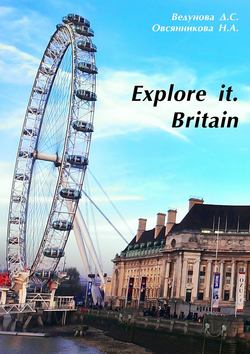Читать книгу Explore it. Britain - Д. С. Ведунова - Страница 2
Geographical location and characteristics of the country
ОглавлениеFeatures of the geographical location and the United Kingdom, located in the British Isles in the north-western coast of continental Europe, traditionally called (by the name of the largest island), the United Kingdom, and the name of its main part of England. Officially it is called the United Kingdom of Great Britain and Northern Ireland. In fact the UK has three historical and geographical areas: England, Wales and Scotland. The structure of the United Kingdom also includes Northern Ireland, which occupies the north-eastern part of the island of Ireland. This is the fourth region of the country. British Isles is the most extensive archipelago in Europe. It consists of two large islands – Great Britain and Ireland, separated by the Irish Sea, and another 5 thousand small islands, among which highlights the three island groups in the North: Hebrides, Orkney, Shetland and the Isle of Man, England and others. The UK is an archipelago of an irregular shape with a very diverse landscape and nature. The last one is due to the fact that the British Isles were once part of Europe, but were cut off from the mainland after the flooding of low-lying land, and now is the bottom of the North Sea and the English Channel. Northern Ireland, which is politically complements the United Kingdom, located on the second largest island of Ireland, and is the western extension of the Scottish mountains. These mountain areas are separated by a narrow channel of the North. The western coast of the island of Great Britain is rocky and steep, east is more gentle. The area of the UK is about 240842 km2 Most of it is the land, and the rest are rivers and lakes. England area is 129,634 km2, Wales is 20637 km2, Scotland is 77179 km2 and Northern Ireland is 13438 km2. Thus, England is bigger than the other countries of the United Kingdom, and has the largest population. These factors explain the dominance of England in British history. The southern end of the island of Great Britain is Cornwall peninsula – is at 50° NL (North latitude), and the most northern part of the archipelago of Shetland Islands are at 60° N.L. The length of the island of Great Britain from the north to south is 966 km. The British archipelago which is located on the Continental Shelf, is separated by the shallow North Sea from Sweden, Norway, Denmark and Germany and by the narrow English Channel (the British call it the English Channel) and Pas-de-Calais from France. Historically, the UK geographic features have influenced human settlement, migration, armed conquest and political union. They also identified the location and operation of industry, transport systems, agriculture, fishing industry, forests, energy and communications. Today, they continue to determine the life of the British, and in addition, they are closely related to public concern about the environment and wildlife. England (population – 48.2 million people) consists mainly of hilly or flat lowland areas with several mountain zones in the north and south-east. But the low hills stretch across most of the country, interspersed with low-lying lands and plains. The population is concentrated mainly around the city of London and even in the south-east of England, west of Birmingham, Leeds, Bradford and Sheffield, north-western industrial Liverpool and Manchester and the north-east of Newcastle and Sunderland. Wales (population – 2.9 million people) is a mountainous country with a territory stretching across the mountains and hills, often terminates in the deep valleys by riverbeds. These mountains gradually decrease and become the highest hills in the east of England. The highest mountains of Wales, located in the north-west, where Mount Snowdon reaches 1085 m. Lowland lands are limited by narrow coastal zones and river valleys in South Wales, where two-thirds of the Welsh population live. In the past, the Welsh mountain terrain hampered the war, agriculture and human settlement. Scotland (population – 5.1 million people) can be divided into three main parts. The first part is the north-western and central mountains with a lot of islands in the western and northern coasts. These lands are densely populated, and account for half of the whole territory of Scotland. The second part is the central low-lying lands, which make up one-fifth of all the Scottish territory, and three-quarters of the population of Scotland, most of the industrial and commercial centers and arable land. The third part is the southern hills, which include a range of hills stretching to the border with England. The highest mountain in Scotland is Ben Nevis (1342 m), which is also the highest mountain of Great Britain. Northern Ireland (population – 1.6 million people) is separated by only 21 kilometers from the Scottish coast, that was the reason for the migration of peoples in the distant past. Since the partition of Ireland in 1921 to the south and west, it borders with the Republic of Ireland. To the north there is a mountainous coast, in the center, close to the south there is fertile valley, and there are the mountains to the west, north-east and south-east.
Questions on the basis of the material studied:
1. What is the total population of the UK?
2. What is the full official name of the UK?
